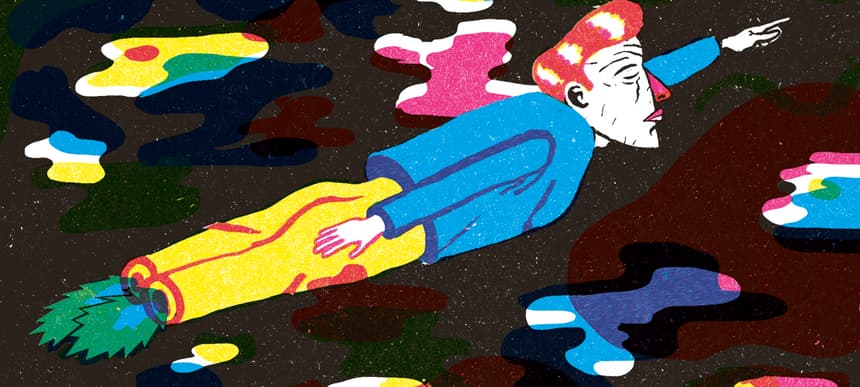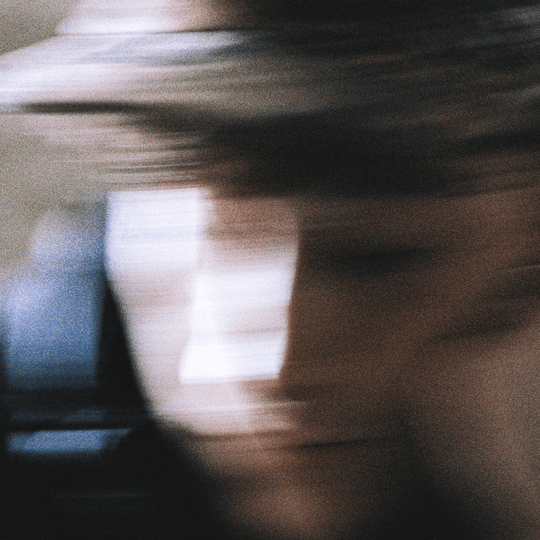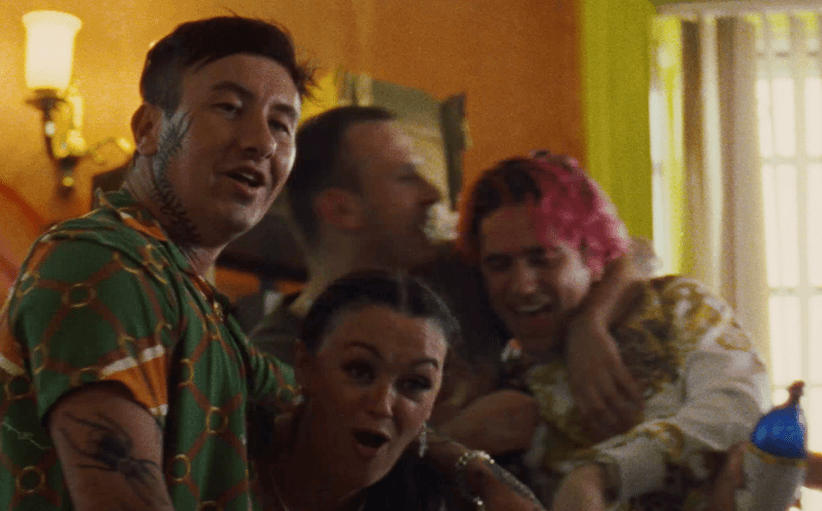
Essay: Invest in Vaporwave Futures!
This essay is the follow-up to an article published about vaporwave on Dummy last year. Reading the 2012 article before diving into this one is recommended but not essential – you can find it here.
So yeah, vaporwave's a thing now. About a year ago I wrote about it in the first of a two-part feature on the "virtual plaza", a metaphor which linked the emerging genre to the grim hi-tech sounds of James Ferraro and a number of artists surrounding Dis magazine. Since then, it's ballooned from a handful of producers – who've now moved on from the style – to a movement involving many dozens of artists at least. No longer does the usually faintly derisive term "microgenre" apply – take a look at the page listing all the Bandcamp albums tagged "vaporwave". Nor can it be dismissed as a novelty genre churned out by crazy internet kids – it now has plenty of stylistic breadth and artistic depth, not that it didn't have enough before. Earlier this year, vaporwave was the subject of two more features, one for the Chicago Reader spotlighting much of the genre's second wave as well as its new live streaming element, and another one two weeks ago, widely read already, for Vice's Thump. So how's vaporwave doing?
Well having said all this, there have been a number of claims, ironic or otherwise, that vaporwave is dead and, in particular, that my article played a significant role in killing it. To the extent that this is a serious assertion, it's something I must take seriously and take responsibility for. My aim is always to create a decent representation of new music, one that can benefit both those who already know it and those who don't yet know it. If this representation leads to the destruction and devaluing of a world that was precious even to just the few dozen people who first created it and observed it, then I'm culpable and I should learn from it. Of course I had little idea that vaporwave would take off the way it did, and some of the adverse effect on its original wave followed from the increased interest and participation it generated from well-meaning on-lookers – the water was fine so more people jumped in, and word spread. Even so, it was me who shouted about it pretty loud and pretty early.
"The incredible thing about vaporwave is it's not emotionally or aesthetically detached, not superficially ironic. Who was I to imply that the work of these bold new producers wasn't sincere?"
Would I change anything about my original article? Yes. In linking it to a bunch of pretty different artists (some of whose music I called "distroid"), certain aspects of the vaporwave aesthetic were emphasised over others. While accelerationism proved a handy concept for transcending assumptions about sincerity or insincerity behind the creation of the music, and while I did frequently assert that the music could be – and was – genuinely enjoyable, the characterisation of vaporwave as a sarcastic, satirical and insincere gesture probably went a little far. I wasn't entirely wrong to interpret it as negatively representing a distance from and even critique of corporate mood music, but doing so was ultimately reductive. On Twitter, Robin Burnett, formerly of INTERNET CLUB, despaired that his music could be reduced to "marxist plunderphonics", a phrase and a sentiment that was spot on. In the past year, I've learned – been taught – that vaporwave is more emotional and more sincere than I expected it to be.
Many of the people I've introduced it to personally have expressed the strongest disbelief that it could be a positive and sincere sound, but the incredible thing about vaporwave is it's not emotionally or aesthetically detached, not superficially ironic. Who was I to imply that the work of these bold new producers wasn't sincere? A cynical British dude from a different generation who grew up venerating that particular, acerbic brand of avant-gardism of Aphex Twin and Radiohead and the disconnected fantasies of post-rock and freak folk, that's who. I would now say that the position of vaporwave is much like that of John Maus on his music: that an essence of something sacred and Utopian can be recovered from a popularly-based musical language stunted by industrial capitalism and the relentless march of time. And what's more, that this can be politically progressive manoeuvre itself, not simply a capitulation to an industrial hegemony. To whatever extent, for producers or listeners, it's sincere or not, the one summary I feel can be made is this: vaporwave is a study in Utopianism.
The two key figures from vaporwave's first wave, Robin Burnett (who was behind INTERNET CLUB) and Vektroid (who is an electronic producer under that name but who was also behind New Dreams Ltd and its subsidiaries) have moved on from the core of the sound, retiring their most famous monikers. After my piece went up, Burnett released three more top-notch albums as INTERNET CLUB: 'VANISHING VISION', 'PURE TRANCE' and 'FINAL TEARS'. I remember listening to 'VANISHING VISION' as I explored the new Westfield shopping centre in London's Stratford, by far the biggest, most modern and most opulent mall I'd ever experienced, on the day after the Olympics opening ceremony – an unforgettable multisensory experience and an educational one. 'PURE TRANCE' features some more uptempo and harder-edged dance flavours, while 'FINAL TEARS' was a little more experimental: by turns chewed-up and monolithic, always troubled and challenging. (The older INTERNET CLUB stuff is still worth checking out if you haven't already – especially the epic 'REDEFINING THE WORKPLACE'.)
Following these final gasps of INTERNET CLUB, Burnett looked back towards his glitch-noise roots. 'Galleria' (as Memorex Dawn) offered a series of fascinating vignettes which seem to take chunks of vaporwave and bury them in hiss and close reverb until they barely reference anything any more – like someone was pulling apart INTERNET CLUB tracks at the other end of an empty classroom or hall. The ending is pure transcendence, and the whole is a concentrated burst of Burnett's best – worth your while. 'Honestly' (as Monument XIII) continued the briefness but returned to an easy-going INTERNET CLUB sound. Then suddenly: 'not 2 far away' (as Wakesleep) brought punishing and highly repetitious but skilled glitch. Recently, Burnett released 'Digital Water' as SunCoast Web Series for the Fortune 500 label, an attractively varied release venturing to the limits of vaporwave and beyond – Diamond World in particular is notable for its monophonic play of sound effects. Burnett's unique talent remains in his avant-gardism and in his startling ability to source the perfect sample again and again, each one yielding a surprising and surprisingly specific mood which, with the right tweaking, regularly transcends that of actual corporate muzak.
At the end of August 2012, Vektroid released 'Shader' as Sacred Tapestry, accompanied by an eerie press release from a PrismCorp announcing: "We are honoured and deeply humbled to receive Your host body donation and look forward to Your continued involvement in the Genetic Re-Engineering Program (GREP). Thank you all for visiting Virtual Casino during our final transmission. We look forward to reconciling with You in the New World Embassy!" 'Shader' is the flipside of 情報デスクVIRTUAL: one of the most composed releases since the Vektroid albums, with plenty of synth patterns and sample collage that approach the kosmiche. Soon afterwards, I discovered that Vek had removed all the faces and human figures from his/her album covers for Beer on the Rug, leaving them with the disturbing emptiness of a deceased loved one's favourite chair. In January this year, Vektroid returned to newly composed electronic music by posting Enemy to the SoundCloud account, a luxurious hi-def journey through synth solos, drum machines and a number of tableaux, each with a genuine spark of future, showing much promise.
Sacred Tapestry III – ドリーミー
In April, PrismCorp was back with two albums for Beer on the Rug as PrismCorp Virtual Enterprises, and if you thought 情報デスクVIRTUAL was pretty full-on, untreated and extensive with its source material then you had no idea. 'ClearSkies™' and 'Home™' sound like they might have been newly composed rather than sampled, or newly rendered from found MIDI files, but it's possible they could have been salvaged wholesale from some arcane corner of the digital plane. Or, like, an old Japanese karaoke machine that magically flies up to your bedroom window just after lights out (but for some reason doesn't wake mom). The tunes are arranged onto synthetic orchestras, blatantly so – blaring trumpets, hip-swinging vibraphones and pitch-bent saxophones. There are some recognisable tunes in there, such as a chipper and remarkably close version of Scritti Politti's 1985 gem Perfect Way (play it to a Scritti Politti fan and the energies that hold them together will cancel themselves out and they'll disappear in a puff of MIDI). Having approached these albums with trepidation, I actually enjoyed them – their honesty and personality soon lifted the self-regulating psychological bars around my soul the way a Daniel Johnston song or Boards of Canada's track Roygbiv or the old Sim City music might. For this and also for being rich and evocative of their titles, 'ClearSkies™'s' highlights are Animation Studio, Deep Jungle Trek and Cascadia (the name of the proposed state Vek lives in), and 'Home™'s' are Newsgroup and Sol Air, which has all the joy of a third-act resolution in a straight-to-video family film.
One of the other original vaporwavers is 骨架的, criminally under-represented in last year's article. I also probably got the name wrong, interpreting it as the Japanese 'Hone Ka Teki' or 'Rack of Bone' – I subsequently realised that the more logical translation was into Mandarin, where the characters can be written 'Gu Jia De', meaning simply 'Skeleton'. 骨架的 uploaded six albums to Bandcamp since the article, only one of which I'd heard, and they're dated back as far as late 2010, making her/him a real pioneer. Sadly, only three remain at the time of writing. As such an early act within vaporwave, 骨架的 is less conceptually developed than New Dreams Limited and INTERNET CLUB-related projects were, so the music is more agonisingly artful adult-contemporary jams than office-block pep, or, as on the debut 'Skeleton', lo-fi experimental sample smelting. The best is probably still 'Holograms', surely a classic of the genre.
Another artist who I missed in the article was Infinity Frequencies, working slightly towards the lo-fi, retro end of vaporwave where it blends with hypnagogic pop, and as such less likely to get away with being genuine background music in today's world. This May, Infinity Frequencies released 'Computer Death', which might be one of the best albums in the vaporwave-hypnagogic nexus, pinning down the choicest dusty butterflies and bottling yesterday's ships with a delicate care and profound restraint. I don't know whether it's an effect of the sense of authenticity that surrounds the original vaporwave artists, but they're still, to me at least, the very best of the genre. It took talent and bold imagination to create the bodies of work I encountered a year ago, and listening back that still shines through, leaving the majority of newcomers in the shade.
Eyeliner's 'High Fashion Mood Music', which I wrote about elsewhere, is in a similar vein to the PrismCorp releases in that it sounds like it was newly composed. Together with PrismCorp (and other stuff out there, no doubt), it constitutes a sub-strain of vaporwave, slightly away from the trance-inducing fogginess of the core sound on account of its higher detail and lesser repetitiousness. 'High Fashion Mood Music' went out on Crystal Magic, a prolific label who've long worked in the New Zealand underground. The witty and mesmerising visual style of the label is certainly in the same business park as vaporwave, but the music ranges into other corners of the virtual plaza and beyond, with most releases being various kinds of punk, hypnagogic or synth-pop (usually all three at once). Closest to vaporwave: Power Windoze's 'Air of Fresh Breath' could be a missing link between John Maus and Laserdisc Visions, 'Power Nap' has hypnagogic funk for Nike and Comic Sans on the cover, and DAIF's 'EZ STREET' is correctly tagged "smooth dude". RealPlayer 7 has three releases – 'Opportunity' is newly composed vaporwave rejected by the corporate client for being too shiny, 'Nights' was rejected for being too steamy, and 'Real' shouldn't be rejected from anything.
RealPlayer7 – Untitled
And what about the rest? Vaporwave producers are not difficult to find any more, and there are now too many of them for me to cover the scene completely. One thing's looking fairly clear: lots of it is less surprising and less creative than what was around a year ago. For many of the artists now discussed as or aligning themselves with vaporwave, the genre is merely a retro, nostalgia thing mostly thought to involve Japan and VHS tapes. Predictably, there has been some confusion between vaporwave, hypnagogic pop and chillwave. OK I'm sorry, I know that there's a special place in hell for people who, like me, constantly strive to maintain a separation between vaporwave, hypnagogic pop and chillwave – it's a back room where Satan forever explains the differences between death metal, black metal and doom metal. But vaporwave and its sibling genres each had different beginnings, different artists and different approaches when they were first identified, before they were blurred together by writers, fans and artists unable to tell the difference between the three. Since the original article, I've come across – thanks go to Patrick McBratney – what is thought to be the first use of the term vaporwave, in a blogpost from October 2011 where it describes Girlhood's 'Surfs Pure Hearts'. In this instance it was used to identify music that was very similar to that of the Not Not Fun and Olde English Spelling Bee labels, that is to say, hypnagogic pop – perhaps the author was unfamiliar with the term.
"Someone posted an image on a 4chan forum which described and complained about 'broporwave', which is to vaporwave what brostep was to dubstep. Although brostep carries associations of added machismo that broporwave doesn't have, the choice of the term to describe a second wave of producers who reduce a genre to a shallow formula is apt."
Yet much of what is being talked about as vaporwave today is much closer to chillwave, which since 2009 has been slowed-down 80s synth funk grooves in a mildly lo-fi atmosphere. Except that the original chillwave artists – Washed Out, Memory Tapes, Neon Indian, Toro y Moi – orchestrated their grooves into songs with lyrics and changing textures. What many "vaporwave" artists are doing is a sort of lazy insta-chillwave, grabbing the nearest chunk of late 80s or early 90s synth-funk pop songs and slowing it down, sometimes without even looping it, as if vaporwave had made it OK to put no thought and effort into making music at all.
You see, there is such a thing as a good vaporwave track, a better vaporwave track. It involves what must be a challenging sample hunt through not old and readily available pop music but through unassuming muzak to find something unfamiliar and yet precisely familiar, something modern but not quite modern, something that is both obviously cheesy and yet clearly affecting. This isn't easy, and the effort and imagination that goes into it is appreciated. Instead however, "vaporwave" is becoming a formula. The point of listening to new music like vaporwave is to be surprised, changed and educated by imaginative artists, and if you're already familiar with James Ferraro, Daniel Lopatin, and the cartloads of screwed lo-fi retro kitsch on the Not Not Fun and Olde English Spelling Bee labels that came out three years ago, and the first vaporwave a year ago, then hearing all this formulaic chillnagogic pop offers you nothing. If you're not, it offers you something that's often inferior.
I'm not the first to raise this opinion. Someone posted an image on a 4chan forum which described and complained about "broporwave", which is to vaporwave what brostep was to dubstep. Although brostep carries associations of added machismo that broporwave doesn't have, the choice of the term to describe a second wave of producers who reduce a genre to a shallow formula is apt. I agree with the post, apart from a horrendously ignorant passage in the third paragraph, but Scott Baldwin disagrees in the link above, perhaps misunderstanding that 'broporwave' implies a degradation of vaporwave, and not vaporwave itself.
The Fortune 500 label, singled out in the broporwave tract, is overwhelming proof that a lot of vaporwave is putting quantity over quality. Though the label name and its art is great, the releases – 30 at the time of writing, starting in January, and literally being released faster than I can write this essay – are mostly unrewarding and exhausting to wade through. I did though (if I hadn't been background music to the work of moving house I'd have lost my mind) and I'm pleased to say there are some decent albums in there. 'MARKET WORLD' by ショッピングワールドjp ('Shopping World, JP') is redeemed for retaining some vaporousness and some weirdness, sourcing some evocative samples and introducing voices. 'ストリート知性dream.boxx' ('Street intelligence dream boxx') by 회사AUTO ('Company auto') has a developed use of glitch, a restless attention span, an original signature technique using low-frequency-oscillating filters, and a bit of a taste for acid jazz: a timely vein left surprisingly untapped by most other vaporwave producers. 日本人 (Japanese) ('Japanese (Japanese)') deserves praise for being extra doomy and droney, like getting lost in a giant greenhouse, going way beyond muzak in the process but never quite losing its connection with vaporwave's subject matter. It also gave rise to this brilliant review.
If the internet is to be believed, 日本人 (Japanese) is an alias of Metallic Ghosts, one of the artists focused on in the Chicago Reader article. Metallic Ghosts was also behind 'The Pleasure Centre', one of a few vaporwave-related releases to seem like it probably is being sarcastically satirical: at the end of the album, an electronic voice asks you "Do you feel satisfied? Do you feel as if you've entered into a whole new chapter of your life? Did you see God? Are you now empathetic and forgiving towards everyone who's ever hurt you? Good, I'm glad. Thank you, and have a good night." 'The Pleasure Centre' is less typical vaporwave than standard virtual plaza shtick, a concept album about futuristic consumption that awkwardly apes James Ferraro's 'Far Side Virtual' but with considerably less sophistication. Perhaps that's the point (it does come with e-voices sardonically proclaiming "real vaporwave shit"), but in haphazardly throwing together a number of fairly average samples and references in a blur that never amounts to pastiche, the end result is bland. Well, one track is called Post-Post-Vaporwave, and I'd struggle to deny that Metallic Ghosts is the accelerationist par excellence, driving the genre into cliché and collapse. Metallic Ghosts's more abstract material, though, such as 日本人 (Japanese) and the pre-vaporwave sampledelic album 'I'm Really Babies' is much more worthwhile.
Perhaps the most successful new vaporwave artist is Saint Pepsi, whose album 'Hit Vibes' is at the top of the vaporwave Bandcamp tag at the time of writing. I can see why Saint Pepsi has ended up in the vaporwave boat, being part of its network and using its sample and loop technique, but s/he mines quite a different cultural area for samples, which generates different sonic and emotional effects. Saint Pepsi samples classic disco, endlessly. It's achieving something quite different to what vaporwave originally achieved by simply finding tasty grooves and locking into them, and I don't personally get much of a buzz out of it. It's not complicating anything, just doing the retro thing: pointing at classic disco and going "hey, check this out". There's nothing wrong with that, of course, but I feel it misses and bypasses the interesting lessons inherent in vaporwave, and what's more, shears the structural richness of its source material off in using vaporwave's looping technique. And for me at least, listening to disco doesn't have the fresh thrill that it might have for other listeners – it was already revived more than a decade ago.
To end on a more positive note: though his tracks never stay online for long, Drip-133 is one new artist that has stood out. His recent album '♡' moved vaporwave towards soulful beats, but his track and then so clear, which dropped off his SoundCloud recently, might well be my all-time favourite wisp of classic vaporwave – I've uploaded it to YouTube with permission [above]. And then so clear unearths vaporwave's roots in the ambient music of Brian Eno, the composer of the Windows 95 sound logo. It samples the end of his track of the same name, from the 2005 album 'Another Day on Earth'. No shame in this at all of course – Drip-133 is in the company of Burial, who sampled Eno in a very similar way on his brilliant track 'Forgive'. Drip-133 lowers the pitch and does some other stuff and makes the original absolutely, absolutely wonderful. As well as being sonically and tonally beautiful, the track evokes not just Eno but intensifies the genuine happiness and comfort that might have been imagined to cocoon techno-corporate worlds thanks to the ambient music Eno wrote for them as a vaporwave pioneer. I see a smiling face dimly superimposed on the clouds on an office block's facade, and can't decide whether the fact that I suppose it's all a dream is making me happy or sad.
In keeping with the vaporwave tradition of proclaiming that it's all over and that one won't concern oneself with the genre any more, I'll close by saying I doubt I'll ever write about vaporwave again, not directly. I don't think it has the open-endedness to keep going and mutating under the same name for many years to come. But what vaporwave has offered the future is new producers with a new calling – I wonder how many of tomorrow's best will say they first joined in with underground new music as part of the vaporwave network, that they started their craft by screwing around with 90s corporate muzak and its deep, latent emotionality. But vaporwave might also have changed the way some of us listen and think about listening- none more than myself – and opened up strange, provocative glimpses of Utopia.













